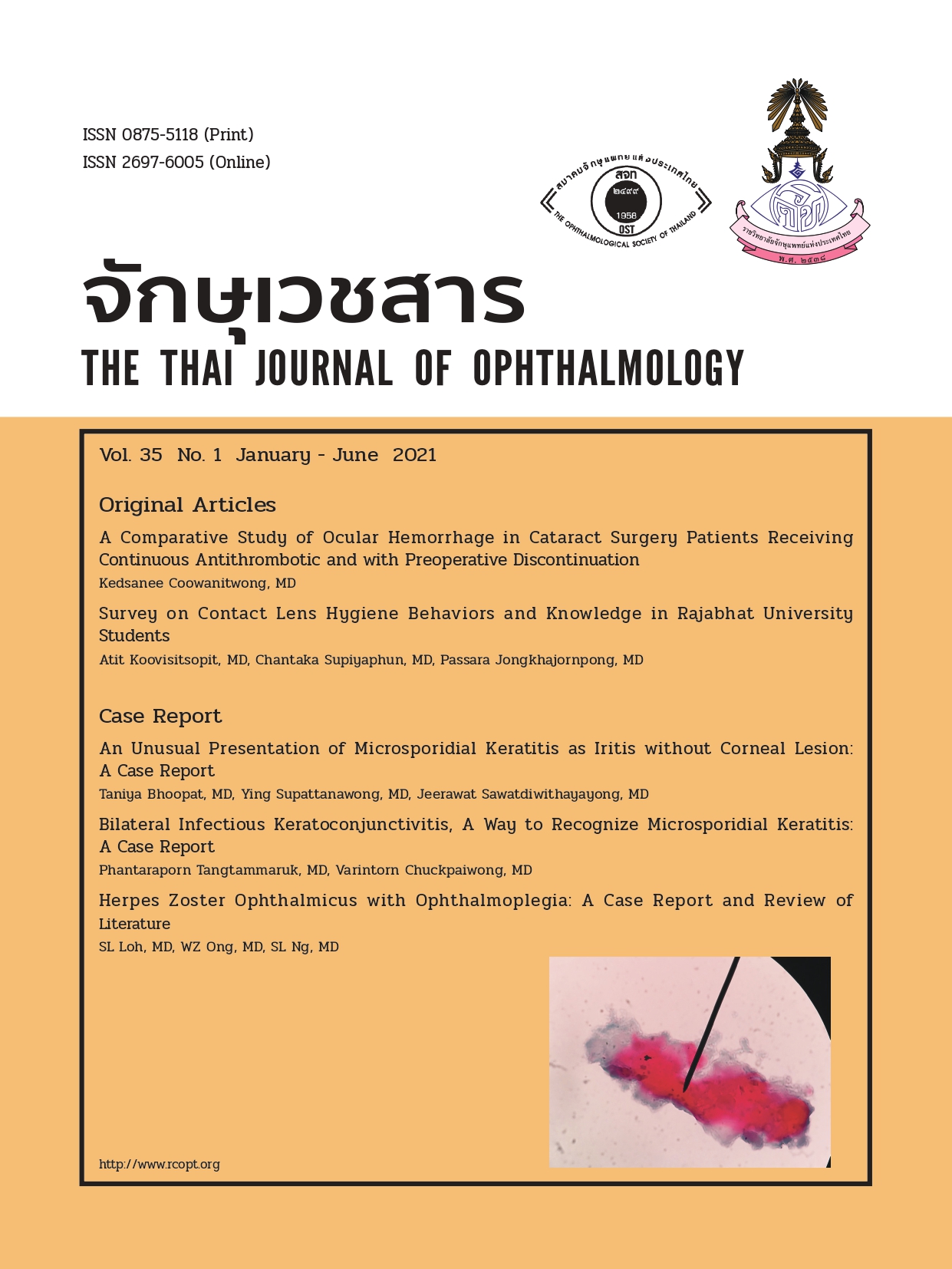A Comparative Study of Ocular Hemorrhage in Cataract Surgery Patients Receiving Continuous Antithrombotic and with Preoperative Discontinuation
Keywords:
cataract surgery, antiplatelet, anticoagulant, complicationAbstract
Objective: To compare the incidence of ocular hemorrhage in cataract surgery between patients who continue
antithrombotic and with preoperative discontinuation.
Method: A retrospective cohort study of patients who on antiplatelet or anticoagulant drugs undergoing cataract
surgery between January 2020 and December 2020 were eligible in the study. Patients discontinued antithrombotic drugs
5-7 days before surgery (discontinuation group) or continued therapy until the time of surgery (maintenance group).
Patients were examined 1 day, 7 days and 1 month postoperatively. Intraoperative and postoperative ocular bleeding and
systemic complications were assessed.
Main outcome measures: Intraoperative and postoperative ocular hemorrhage and thromboembolic complications.
Results: 288 eyes of 274 patients were included in the study. The maintenance antiplatelet/anticoagulant group
comprised 115 eyes, the discontinuation group comprised 173 eyes. There was no sight threatening intraoperative bleeding.
Sixty-eight eyes (40.5%) in the discontinuation antiplatelet group and twenty-six eyes (24.5%) in the maintenance
antiplatelet group had subconjunctival hemorrhages (p=0.01), associated with local anesthesia (OR 48.78, 95%CI 18.45-128.97). Using multivariable analysis, maintenance antiplatelet did not increase risk of subconjunctival hemorrhage (OR
0.55, 95%CI 0.27-1.11). There was no significant difference regarding hemorrhages between the discontinuation and the
maintenance group in anticoagulant and dual antiplatelet therapy. During the 1-month postoperative period, patient in the
discontinuation and the maintenance antiplatelet group had thromboembolic complication 1 case in each group.
Conclusions: Minor ocular hemorrhage occurred 34% of eyes, with no significant difference between discontinuation
and maintenance antiplatelet. There was no significant difference in the incidence of sight threatening hemorrhage and
systemic complications.
References
World Health Organization. A framework and indicators for monitoring VISION 2020-The Right
to Sight. Report of a WHO Working Group. Geneva: WHO;2002.
Benzimra JD, Johnston RL, Jaycock P, et al. The Cataract National Dataset electronic multicentre audit
of 55567 operations: antiplatelet and anticoagulant medications. Eye (Lond) 2009;23:10-16.
Garcia Rodriguez LA, Cea Soriano L, Hill C, et al. Increase risk of stroke after discontinuation
of acetylsalicylic acid: a UK primary care study. Neurology 2011;76:740-6.
Fleisher LA, Beckman JA, Brown KA, et al. ACC/AHA 2007 guidelines on perioperative cardiovascular
evaluation and care for noncardiac surgery: executive summary- a report of American College of Cardiology/
American Heart Association Task Force on Practice Guidelines (writing Committee to Revise the 2002
Guidelines on Perioperative Cardiovascular Evaluation for Noncardiac Surgery). J AM Coll Cardiol 2007; 50:1707-32.
The Task Force for Preoperative Cardiac Risk Assessment and Perioperative Cardiac Management in Noncardiac Surgery of the European Society of Cardiology (ESC) and endorsed by the European Society of Anaesthesiology (ESA). Guidelines for
preoperative cardiac risk assessment and perioperative cardiac management in noncardiac surgery. Eur Heart
J 2009; 30:2769-12.
The Royal College of Ophthalmologist. Cataract Surgery Guidelines. London, UK, Royal College of Ophthalmologists. 2004; updated 2010.
American Academy of Ophthalmology. Cataract in the adult eye Preferred Practice Pattern. Preferred Practice
Pattern. Volume 124, Issue2, PP1-P119, February 01, 2017. https://doi.org/10.1016/j.ophtha.2016.09.027
Katz J, Feldman MA, Bass EB, et al. Risks and benefits of anticoagulant and antiplatelet medication use before
cataract surgery. Ophthalmology. 2003 Sep;110(9): 1784-8.
Ong-Tone L, Paluck EC, Hart-Michell RD. Perioperative use of warfarin and aspirin in cataract surgery by Canadian Society of Cataract and Refractive Surgery members: survey. J Cataract Refract Surg. 2005;31:991-6.
Chaidaroon W, Tungpakorn N, Puranitee P. Current trends in cataract surgery in Thailand-2004 survey. J Med Assoc Thai. 2005;88(Suppl 9):S43-50.
Nakaphongse S, Tulvatana W, et al. Incidence and factors associated with complications after retrobulbar anesthesia in Thailand: results from King Chulalongkorn Memorial Hospital. Asian Biomedicine. 2009;3(6):735-8.
Kallio H, Paloheimo M, Maunaksela EL. Haemorrhage and risk factors associated with retrobulbar/peribulbar
block: a prospective study in 1383 patients. Br J Anaesth. 2000;85:708-11.
Katz J, Feldman MA, Bass EB, et al. Risks and benefits of anticoagulant and antiplatelet medication use before cataract surgery. Ophthalmology. 2003;110:1784-8.
Takaschima A, Marchioro P, Sakae TM, et al. Risk of hemorrhage during needle-based ophthalmic regional
anesthesia in patients taking antithrombotics: a systematic review. PLos One. 2016;11:e0147227.
Huebert I, Heinicke N, Kook D, et al. Dual antiplatelet inhibition in cases of severe retrobulbar hemorrhage following retrobulbar and peribulbar anesthesia. J Cataract Refract Surg. 2015;41:2092-101.
Nathaniel R, Smilowitz, Jeffrey S, et al. Perioperative Cardiovascular Risk Assessment and Management for Noncardiac Surgery. A Review. JAMA 2020; 324(3):279-90
Obuchowska I, Mariak Z. Risk factors of massive suprachoroidal hemorrhage during extracapsular
cataract extraction surgery. Eur J Ophthalmol 2005; 15:712-7.
Jamula E, Anderson J, Douketis JD. Safety of continuing warfarin therapy during cataract surgery: a systematic review and meta-analysis. Thromb Res. 2009;124:292-9.
Makuloluwa AK, Tiew S, Briggs M. Perioperative management of ophthalmic patients on anti-thrombotic agents: a literature review. Eye. 2019;33:1044-59.
Dunn AS, Turpie AG. Perioperative management of patients receiving oral anticoagulants: a systematic review. Arch Intern Med. 2003;163:901-8.
Downloads
Published
Issue
Section
License
The Thai Journal of Ophthalmology (TJO) is a peer-reviewed, scientific journal published biannually for the Royal College of Ophthalmologists of Thailand. The objectives of the journal is to provide up to date scientific knowledge in the field of ophthalmology, provide ophthalmologists with continuing education, promote cooperation, and sharing of opinion among readers.
The copyright of the published article belongs to the Thai Journal of Ophthalmology. However the content, ideas and the opinions in the article are from the author(s). The editorial board does not have to agree with the authors’ ideas and opinions.
The authors or readers may contact the editorial board via email at admin@rcopt.org.


